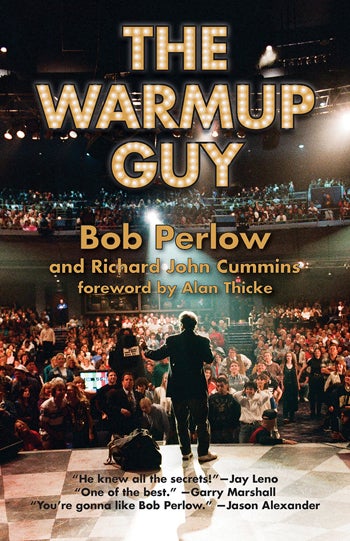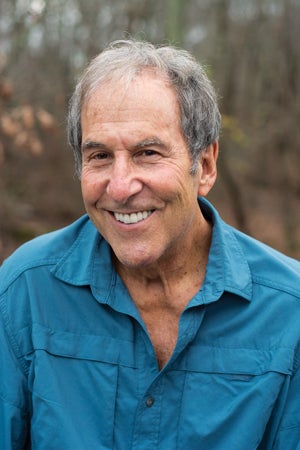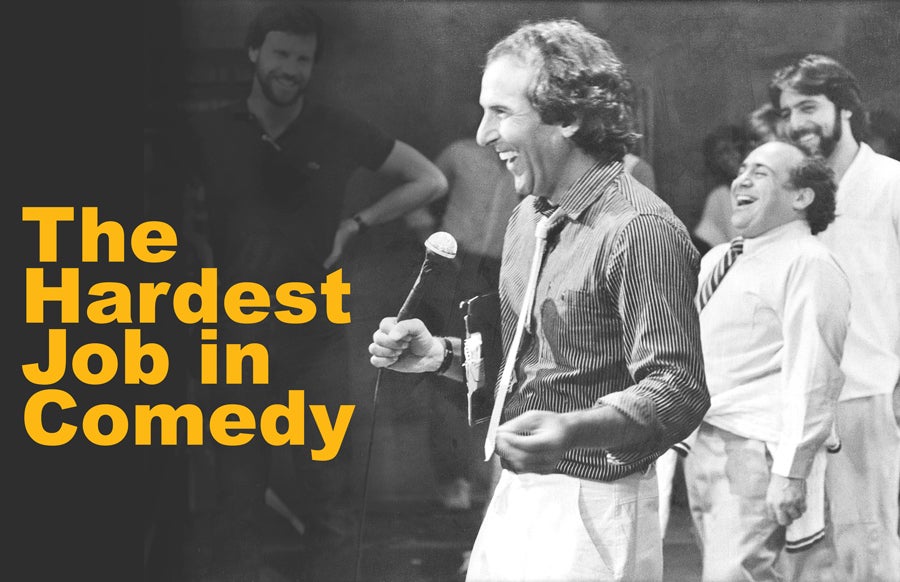
By Melanie Coon
Imagine getting up in front of a huge studio audience and trying to make them laugh. Cold sweats yet? Now imagine they didn’t come to see you, have no idea who you are, and that you’re keeping them jolly in between takes, and retakes, and more retakes, of a sitcom…for three hours, and sometimes six. If you can pull that off, you’re a warmup guy. One man perfected the form.
The old saw dictates that if you love what you do, you’ll never work a day in your life, and for once it’s not overstating the case to say those words apply to Bob Perlow ’67, M.S ’70, who for more than four decades was surely one of the hardest working comedians in L.A.—and has a trove of insider stories about the likes of Robin Williams, Ted Danson, and Jason Alexander to prove it.
Growing up in Pawtucket, Rhode Island, during the 1950s, Perlow spent Sunday nights watching The Ed Sullivan Show. It was the first golden age of television, as he fondly recalls, and like most kids of that era, he watched his share of TV. But his path to becoming The Warmup Guy, a career conjured out of happenstance and tenacity that he lays out in his book of the same name, was far from preordained.
Perlow’s family was known in Pawtucket for their shoe store. To this day, people he encounters in Rhode Island, upon hearing his last name, say, “Oh, the shoe people!” Perlow describes his affable father as being “like the mayor of Pawtucket,” a man who knew everyone in town. After graduating from Pawtucket West High School (now Shea High School), Perlow headed to URI in 1963, and stayed on to study for a master’s in business. He’s honest about having pretty modest ambitions at that point. Avoiding the draft was among his topmost priorities.
Other than a few colorful temporary jobs, including ballroom dance instructor, Perlow followed a fairly conventional route next. He taught retailing and marketing at Johnson & Wales before becoming a professor at Chamberlayne Junior College in Boston.
So how does a business professor morph into a warmup guy?
At a recent informal URI reunion, an old friend reminisced about how funny Perlow had been during lunch at the Union. “I was never a joke teller,” Perlow muses. “But I guess I could present stories in a way that made other people laugh. It never occurred to me that I would end up in show business.”
And yet the young professor answered an ad in the Boston Phoenix that asked, simply, “Are you funny?” Looking back, Perlow says, “That took a lot of nerve. There must have been a part of me that thought, ‘Yeah, I’m funny.’”
An aspiring young comic named Jay Leno also answered the ad, and the two joined an improvisational troupe called Fresh Fruit Cocktail, playing bars, colleges, and even the Playboy Club. They became fast friends, and that friendship would deepen as their paths diverged and came together in the course of the next four decades.
But first, Perlow took a surprising detour, leaving the professorial life, the improv troupe, and the cold winters of the Northeast to seize a unique opportunity to become a cruise ship director in the Caribbean. Appreciating Perlow’s success at keeping the passengers engaged and happy, the cruise ship company offered him the chance to move to California, where, on his 30th birthday, he started a gig as a tour bus guide—in a state he’d never even visited. He recalls making things up as he went along. “Folks, there’s Millard Fillmore Rock,” he would say, inventing a story about how a particular rock, when viewed in a particular light, looked exactly like the 13th president. Or, “Here’s Doris Day’s house,” when passing by a house whose occupants were completely unknown to him.

“What kept me going during those two years was not the job,” Perlow notes. “But I had reconnected with Jay. We were roommates. We even bought a motorcycle together. While he was perfecting his standup act, performing for $25 a night, I was leading bus tours and taking an improv comedy class.” His classmates in that improv session? Robin Williams and Paul Reubens. “We were having a great time,” Perlow recalls. But Leno “was far more serious than I was about breaking into television.”
Still, leading bus tours for impatient New York tourists was tedious, and Perlow was tempted by another Caribbean opportunity, this time to buy a share in a buddy’s bar in St. Martin. But another improv classmate, Marc Sotkin, was a writer on the most popular show on television at the time, Laverne & Shirley. He told Perlow to hold off on the flight south. Soon after, Sotkin brought Perlow on board as part of the Laverne & Shirley writing team. At the time, sitcom writers would often take turns trying to warm up the audience—it wasn’t a specialized job, and it didn’t get much respect. So when Gary Marshall—the series’ creator and producer, and brother of Penny Marshall, one of the show’s stars—approached him, Perlow wasn’t even nervous. “He came to me and said, in his unforgettable Brooklyn accent, ‘Hey Bob, we have a dead audience tonight, go out there . . . and be funny!’” The moment defined the next 35 years of Perlow’s life.
He became the full-time warmup guy for Laverne & Shirley, and along the way saw real possibilities for legitimizing the job. So Perlow audaciously asked the producers of the next show he worked on, Angie, for $300 a night—even though $50 was the going rate. When the producers balked, Perlow offered to warm up the audience for free. In that taping, he delivered laughs and a standing ovation not only for the cast but also for the writers—and the producers were suddenly happy to pay him his asking price. “It wasn’t just their egos,” he explains. “The actors, when they heard the love from the audience—they really stepped up their game, which in turn made the show that much more entertaining. The producers decided it was worth the ungodly sum of $300.” So Perlow’s bet on himself paid off, and his career in warmup was born.
The way he describes it, being a warmup guy is not about telling jokes. And it is definitely not an easy job. When Perlow started, most warmup guys (there were no warmup gals) weren’t all that good at it. After all, writers, even if they are comedy writers, are not necessarily good at schmoozing and performing. Some were aspiring comics themselves and wanted to run through their jokes—but Perlow points out that in most cases, that’s only about an hour of material. Meanwhile, tapings for 30-minute shows can run several hours (see his book’s chapter on Friends).
“I made an effort to never go the ‘Hey, where ya from?’ route. I saw my job as keeping the audience engaged and bringing them back to the show,” Perlow says. “Even if they had heard a joke told multiple times as takes went on and on, it was my job to deliver laughs for the cast and the writers each time.” Meanwhile, the writers were often rewriting the script as the taping progressed—and needed the audience to stay fresh so they could gauge the success of their changes. Perlow drew on his background in improv, his imagination, and especially his cruise director and tour guide experience, which served him well when facing audiences who had no idea what they were getting themselves into by reserving tickets for a taping. “Between takes, when it was just me and the audience, I had them dancing, playing games, I gave out hats, shirts. I kept them engaged with the storyline,” Perlow says. “Most of all, I kept them there. And believe me, after six hours, there were plenty of people who wanted to leave—or kill me. There were some nights I would have welcomed it.”
In his foreword to Perlow’s book, actor Alan Thicke—the Growing Pains star passed away in December, distressing Perlow, who was a groomsman at one of his weddings—confirmed Perlow’s talents. “He was never a ‘set-up-and-joke’ type, but rather a comedic performance artist,” wrote Thicke, “a walking reality show who engaged with the audience, improvising seamlessly with them until everyone is laughing—which never takes long with Bob.”
From Taxi to Cheers to Who’s the Boss? to Newhart, which was one of his absolute favorites, Perlow worked on more than 100 shows in his career. Some days he would warm up three audiences, racing between studios. As Perlow recounts the highs and occasional lows of working with the casts and crews of the most popular shows of a generation, his joy in doing the work shines through. His book offers the perspective of both witness to and historian of an era in which television was continually reinventing itself as a medium. Here’s just one example: “On Mork & Mindy,” Perlow recalls, “it was the stuff that wasn’t filmed that was so priceless. I would implore the audience, ‘Folks, please remember this—it’s going in the comedy time capsule and it will never be seen again.’”
Reuniting with Jay Leno on The Tonight Show is what Perlow considers the crowning achievement of his career. He was with the show from 1994 to 2010. As he puts it, “Fifteen years, five days a week, I never missed a show and I never got nervous.” Leno joined Perlow at a book signing in October, where the two had a great time reminiscing for the crowd—warming them up for their reading experience.
Citing “brutal ageism” in Hollywood, Perlow made the decision to leave when he was still in top form. He returned to Rhode Island, a state he says he has always loved. Planning to retire as a “gentleman fisherman,” Perlow got bitten by the showbiz bug again and simultaneously wrote The Warmup Guy while creating his show, Tales from Hollywood, as a kind of live complement to the text. It’s a nostalgic experience for baby boomers, who come to hear about their old favorite shows and what happened behind the curtain. The show is audience-driven. Perlow’s extensive photograph collection—he took photographs with just about every celebrity he ever worked with—flashes up on a screen, and a program listing all the shows he worked on serves as a prompt. Audience members can ask about any of the stars and shows listed and Perlow shares his memories. “It’s very different than the shows I did in Hollywood,” Perlow says, “and in many respects more rewarding. I actually get to speak to individual people. When I was warming up for crowds of hundreds or thousands, there was no chance to answer questions or connect on a personal level.”
Reflecting on sitcoms today, Perlow notes that many shows bear little resemblance to the comedies he warmed up. “With one camera and no studio audience, you have to rely solely on the material. There’s such a leap of faith there—it’s a huge difference.”
Still, Perlow is proud of elevating warmup to an art form. He quips, “What Edison was to electricity, I was to the warmup.” Then, turning more thoughtful, he adds, “I was very lucky to have spent my adult life doing a job that I loved, looked forward to, and was good at. When people ask me if I know how lucky I am, I always tell them: You bet I do. I’m the luckiest guy in the world.” •
Upcoming Performance
Perlow will be offering his signature personal, behind-the-scenes look at some of television’s most famous shows and actors at the Kingston Free Library on Wednesday, March 22, at 6:30 p.m. Register for the free event by calling 401-783-8254 or email nnadeau@skpl.org. Kingston Free Library, 2605 Kingston Road, South Kingstown, R.I.

 Home
Home Browse
Browse Close
Close Events
Events Maps
Maps Email
Email Brightspace
Brightspace eCampus
eCampus



